Most people assume a washing machine cleans itself because it runs with soap and water. Then the clean clothes start to smell musty, and the blame lands on the laundry. The truth is, the washing machine can be the source.
Inside any washer, residue from detergent, fabric softener, and dirty water sticks to hidden parts. The space is dark, warm, and damp, which invites mold and mildew. Over time, both top-loading and front-loading washers build up grime and start to stink.
This guide explains why a washing machine smells, how often to clean it, and what actually works. Simple items like baking soda, white vinegar, and bleach remove gunk without fancy tools. Step-by-step instructions cover both types of machines along with quick habits to deep clean washing machine smelling fresh.
Key Takeaways
- Clean the washing machine monthly or after 30 cycles to stop odor and buildup. Do a deeper clean every six months.
- About 16% of front-loader owners report mold and odor issues, often in the door gasket and detergent drawer.
- Run a hot cycle with two cups of white vinegar or an Affresh tablet, then wipe the gasket, drum, and dispensers each month.
- Use the detergent amount on the label. Extra soap creates residue that traps bacteria and smells bad.
- Leave the door open between washes. Better airflow reduces musty odors by up to 75% in studies from 2023.
Why Does Your Washing Machine Develop Odor and Buildup?
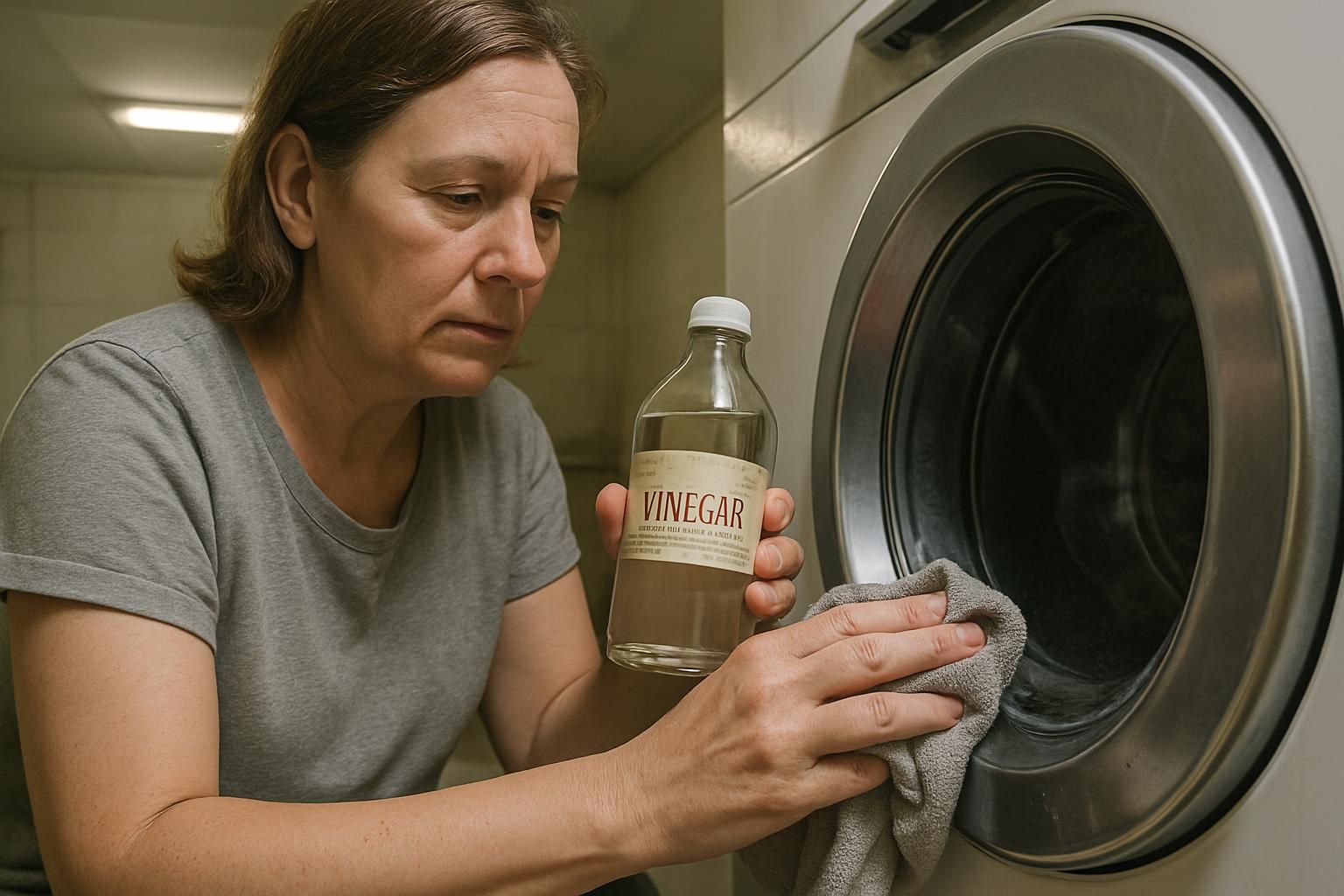
A washing machine traps moisture and leftover soap. That mix becomes sticky film, odor, and gunk. Basic washing machine maintenance keeps grime away so clothes come out fresh each cycle.
Causes of Mildew and Mold Growth

Too much detergent or fabric softener leaves extra residue in the drum and dispensers. That residue becomes food for microbes, the tiny organisms that include bacteria and fungi. Damp spots such as the rubber door seal, called a gasket, and the detergent tray are common trouble areas in a front-loading washing machine.
Front-load owners report more odor complaints, with 16% saying mold or smell is a problem. The door design holds moisture against the gasket, so mildew grows even if a washing machine cleaner is used sometimes. Wet towels left inside speed up growth. Poor drainage or an unbalanced machine can leave standing water behind.
Microbes survive normal cycles when moisture lingers. Over time they damage rubber parts and spread odor. Using the right detergent dose and letting the washer air out after use cuts the risk and keeps the washing machine fresher.
Residue from Detergents and Fabric Softeners
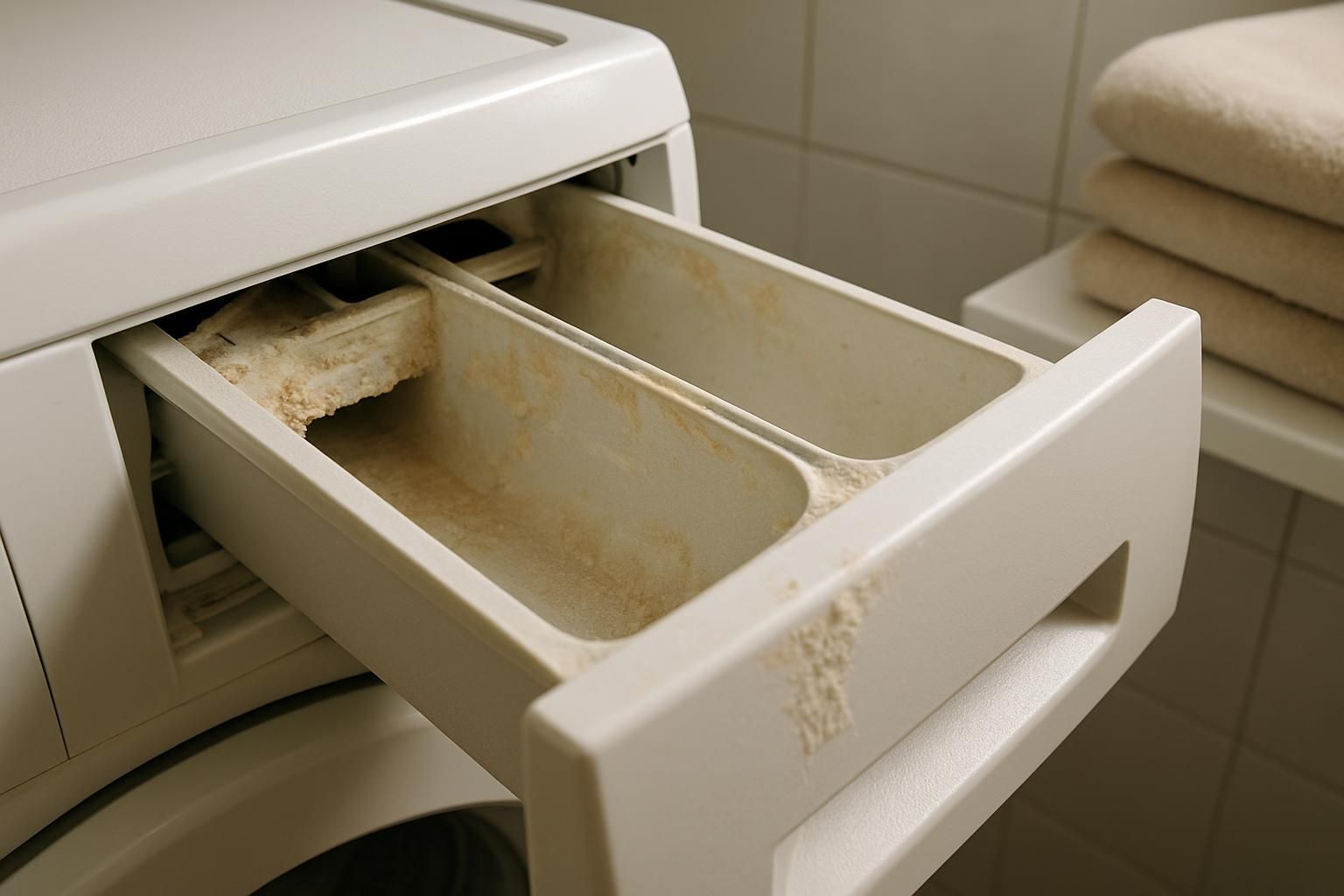
Damp surfaces make residue stick even more. Detergents and fabric softeners can leave a waxy film inside the machine. High efficiency models use less water, so extra soap does not rinse away and ends up coating the drum and hoses.
That buildup hides where water rarely reaches, like under some agitators or inside dispenser compartments. A small amount of all-purpose cleaner or dish soap on a soft brush helps strip away sludge in these spots. White vinegar also loosens softener residue fast.
Cleaning the dispenser monthly and measuring detergent each load keeps the balance right. These small steps protect a clean washing machine and help every cycle run odor free.
Improper Ventilation and Maintenance
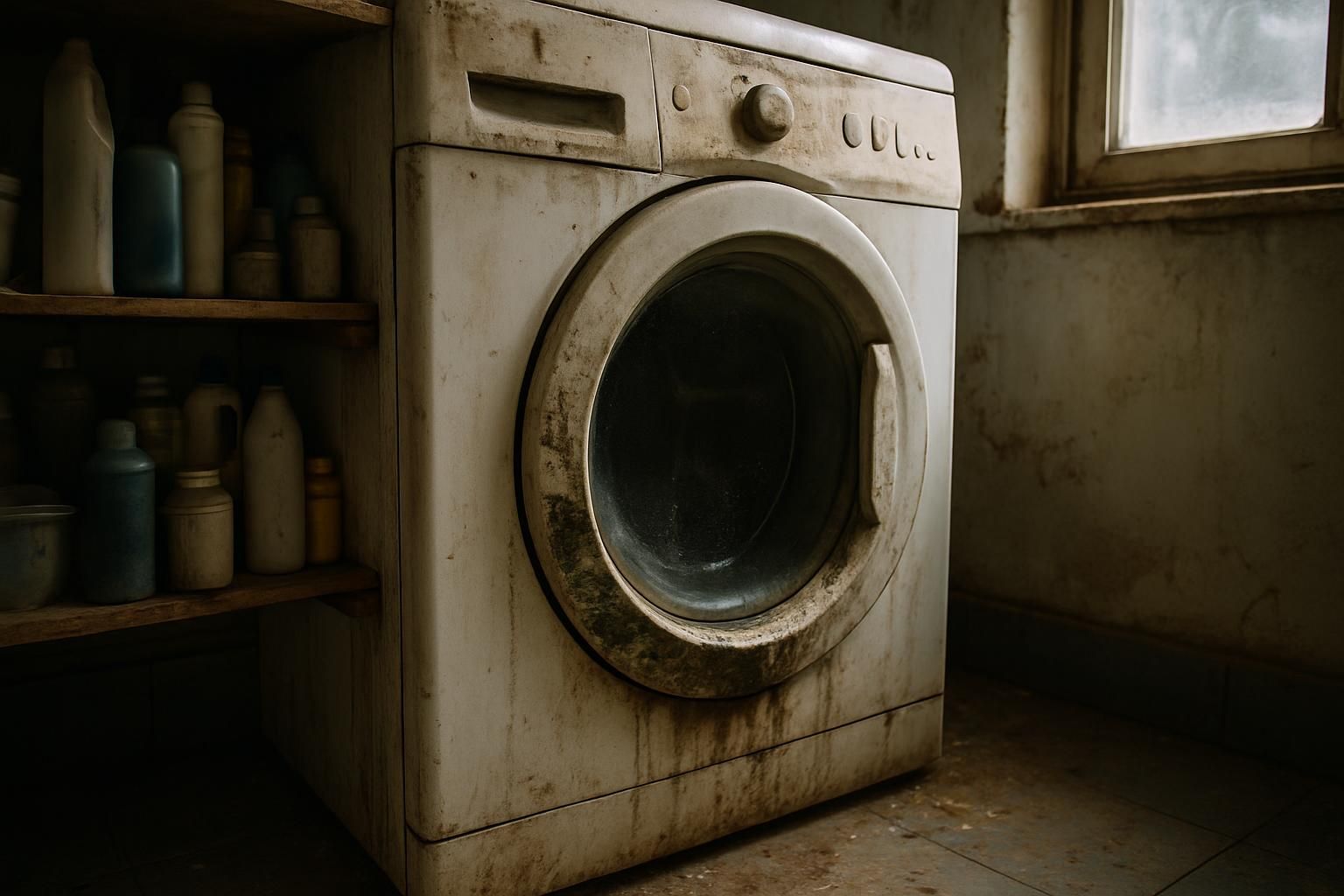
Moisture trapped in the door seal or drum fuels mildew and odor. Closing the door immediately after a cycle keeps the inside wet. Leaving the door open between loads lets parts dry out faster.
Over 60% of odor complaints come from front-loaders with poor airflow. Monthly washing machine maintenance, quick gasket wipes, and a regular cleaning cycle reduce those smells. Using too much detergent adds sticky residue, which feeds bacteria and makes odor worse over time.
Simple habits, including checking filters, go a long way toward a cleaner, longer lasting machine.
How Often Should You Clean Your Washing Machine?
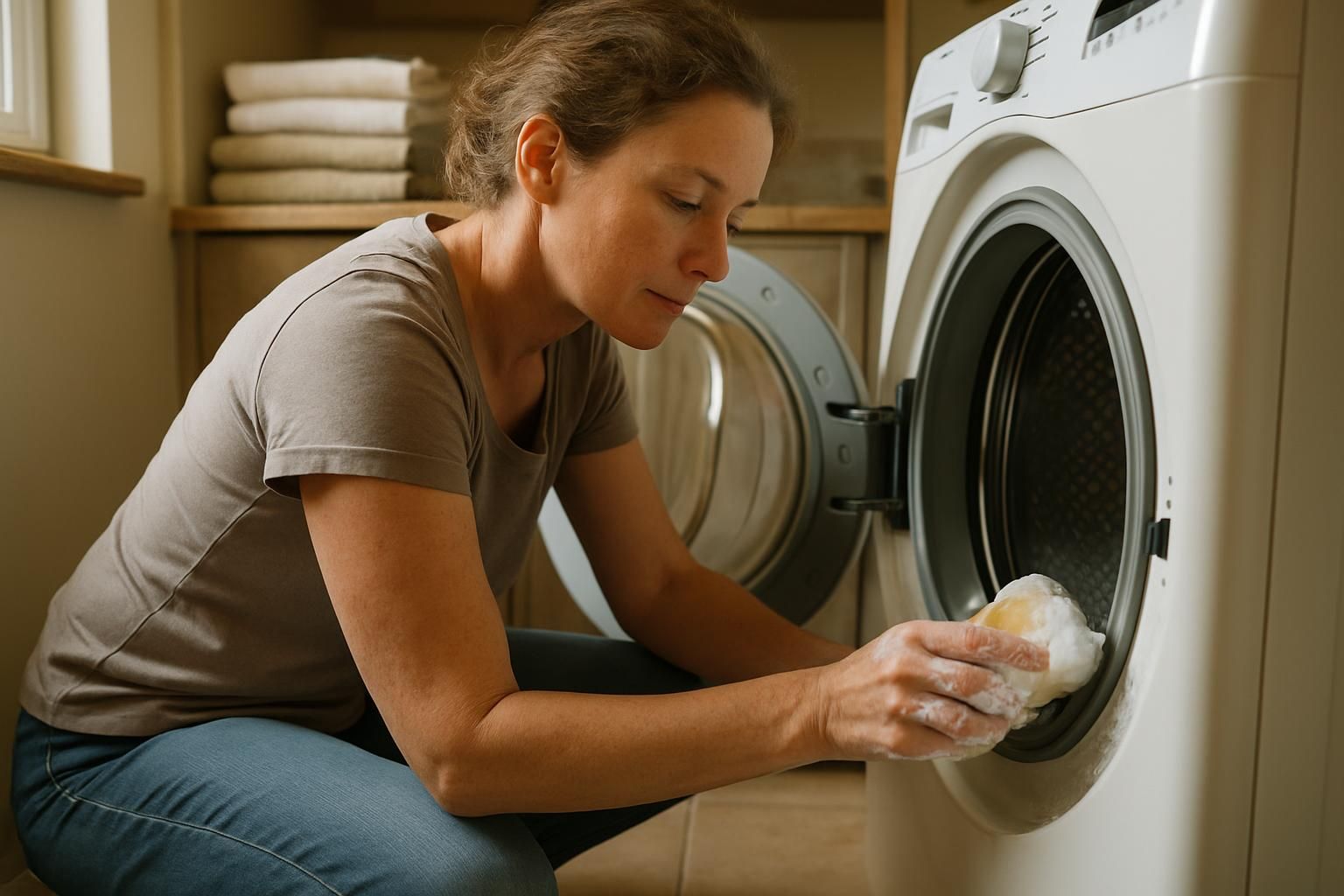
Most experts suggest cleaning the washing machine every 30 days or after 30 wash cycles. If a load is heavily soiled or dyes bleed, clean right away to stop odor. A steady routine keeps laundry fresher and supports energy efficiency.
Manufacturers also recommend a deep clean about every six months, even with monthly care. A washing machine cleaner, or simple items like baking soda and vinegar, helps prevent residue from forming. Knowing the right method for a front-loading washing machine versus a top-loading model matters because the parts trap moisture in different places.
Cleaning a Front-Loading Washing Machine
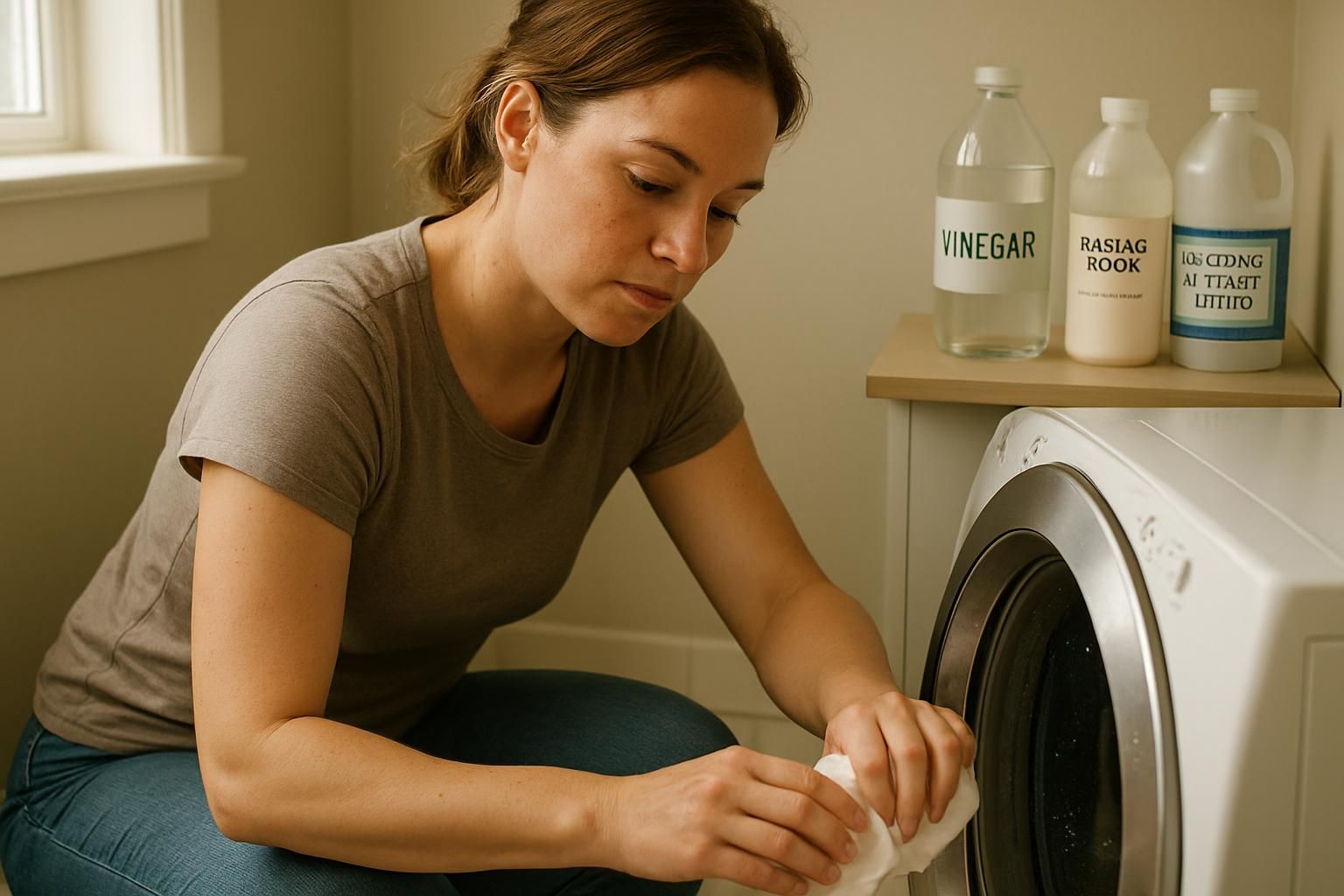
Front-loaders need attention in a few key spots, then a hot cleaning cycle. Vinegar, baking soda, or an effective washing machine cleaner gets it done, and the steps are simple.
Step 1: Wipe Down the Door Gasket

Odor often starts on the rubber door gasket where water sits after a cycle. Lift each fold of the gasket and inspect for grime, lint, or trapped hair. A soft cloth dipped in white vinegar cuts slime and helps kill bacteria that grow in damp creases.
Clean this area at least monthly, more often for busy households. This simple habit prevents mildew and supports reliable washing machine maintenance.
Step 2: Clean the Detergent Dispenser
Pull the dispenser drawer all the way out and rinse it under warm water. Use a soft brush or an old toothbrush to scrub corners and remove sticky film. Clear any lint from each compartment, then let the parts dry and reinstall.
Many drawers are dishwasher safe, which makes deep cleaning quick for busy families. Keeping this area clean reduces odor and buildup that can spread back into the drum.
Step 3: Run a Cleaning Cycle with Vinegar or Affresh Tablets
After the dispenser is clean, deep clean the drum. Pour 2 cups of white vinegar and 1/4 cup of baking soda directly into the empty drum. Select the hottest, longest cycle available.
The vinegar dissolves detergent film while the baking soda neutralizes odor and helps loosen hard water deposits. If preferred, use an Affresh tablet instead. Place one tablet in the drum and run the machine’s cleaning cycle or the hottest, longest wash.
Repeat this process monthly or every 30 cycles. Regular cleaning keeps the washing machine fresh and ready for laundry.
Step 4: Clean the Drum with Baking Soda
For added odor control, sprinkle 1 cup of baking soda into the empty drum. Run the hottest, longest cycle, such as sanitize or heavy duty. When the cycle ends, wipe the drum, door, and gasket with a soft cloth to remove loosened residue.
Use this step once a month. It boosts results from the prior cleaning cycle and helps keep odors away.
Step 5: Wipe the Exterior
Finish by wiping the outside. Use a damp cloth and a mild soap to clean the top, sides, control panel, and door. Skip harsh chemicals that can damage finishes.
A quick wipe a couple of times each month keeps the space cleaner and reduces the chance of grime getting inside the drum.
Cleaning a Top-Loading Washing Machine
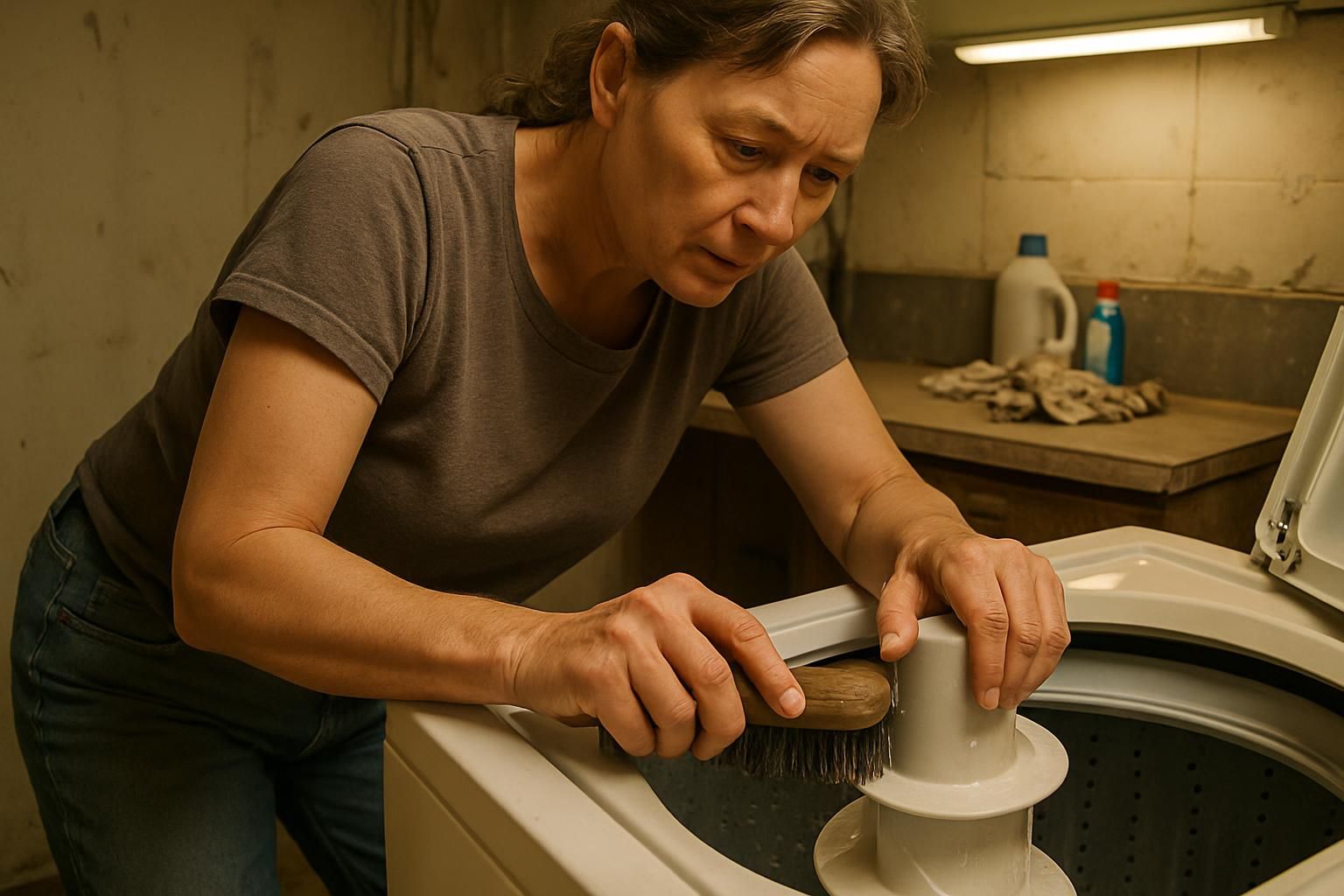
Top-loaders collect residue around the agitator and along the drum. A focused clean clears both areas so the machine runs better and smells clean.
Step 1: Clean the Agitator and Drum
Remove all laundry and, if the design allows, take off the agitator cap. Some models, like Whirlpool’s 2-in-1 removable agitator, make this easy. Check the owner’s manual before using any tools.
Scrub inside the agitator with a soft brush dipped in hot, soapy water. Wipe the drum with a microfiber cloth and a mix of hot water with a small amount of vinegar or hydrogen peroxide. Pay attention to the base of the agitator where residue collects.
Plan a deep clean of the agitator and drum every six months to keep odor under control.
Step 2: Run a Cleaning Cycle with Bleach or Vinegar
Pour 4 cups of chlorine bleach into the empty drum. Choose the hottest, longest cycle. Let the tub fill, then pause for a 60-minute soak. Restart and finish the cycle to sanitize the interior.
Next, run another hot, long cycle using 4 cups of white vinegar. Pause to soak for an hour, then complete the cycle. Some owners use only 1 cup of bleach, but the larger amount tackles heavy buildup better. Follow the manufacturer’s safety directions when using bleach.
During this time, soak removable dispensers in hot vinegar to loosen grime.
Step 3: Rinse with Baking Soda
After the bleach or vinegar steps, add 1/2 cup of baking soda to the empty drum. Run a short, hot wash. Baking soda neutralizes lingering odors and clears leftover soap film.
When the cycle ends, dry the drum, lid, and rubber parts with a clean cloth. Repeat monthly for a fresh, clean washing machine.
Step 4: Clean the Dispensers
Remove the detergent and softener dispensers. Soak them in hot water with 1 cup of vinegar. Use a small brush to clean tight corners and rinse well.
Regular attention here blocks mold growth and keeps the machine smelling clean.
Step 5: Wipe Down Exterior Surfaces
Wipe the outside with a damp cloth and mild soap. Focus on control buttons and handles where residue collects. Avoid harsh cleaners that can harm paint or plastic.
Weekly surface care supports a cleaner laundry area and extends the life of the machine.
Tips to Keep Your Washing Machine Fresh Between Cleanings
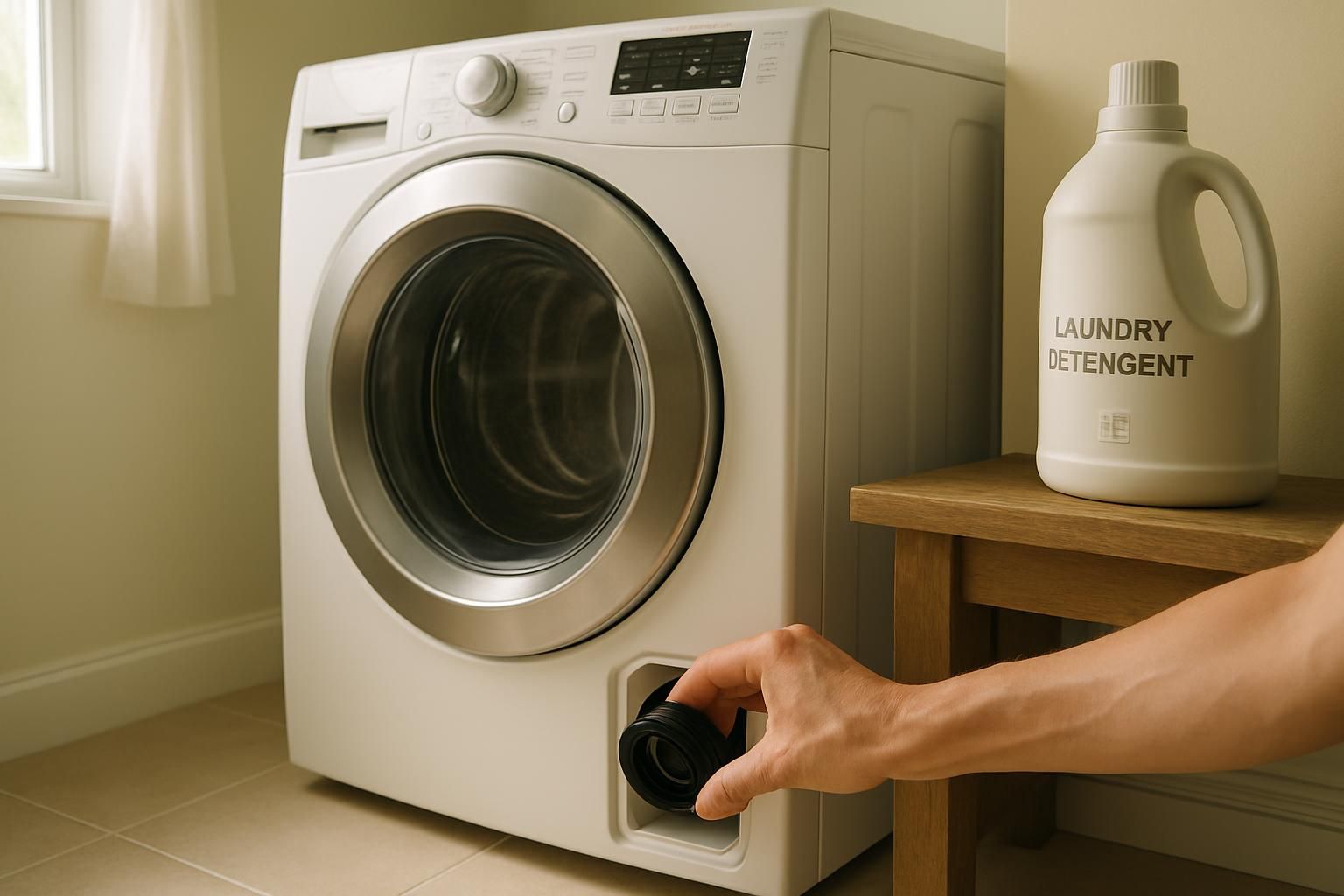
Small habits matter. A little airflow, the right soap dose, and a clean filter prevent most odor problems before they start.
Leave the Door Open After Use for Ventilation
Leave the washer door open after each load so air can circulate. Brands like Whirlpool and GE Appliances recommend this to dry the drum and gasket. If the door closes right away, moisture gets trapped and mildew grows fast.
Drying the seal with a cloth adds extra protection. Studies from 2023 found that machines left open between washes smelled fresher up to 75% longer. This simple step protects both family health and the machine’s lifespan.
Use the Correct Amount of Detergent
Using too much detergent creates sticky residue inside the machine. That film traps moisture and feeds bacteria, which causes odor. The problem gets worse when excess soap mixes with fabric softener and forms a waxy layer.
Manufacturers, including Whirlpool and Maytag, print exact doses on bottles and drawers. High efficiency washers need less soap to prevent extra suds and buildup. Measure each load and use the correct dispenser slot. This saves money and reduces odor.
Regularly Clean the Filter
Lint, hair, and small items clog the filter and slow draining. Many brands, such as Whirlpool and LG, suggest checking the filter monthly. A clogged filter can leave clothes musty or even cause leaks.
Open the cover, remove debris with gloves or tweezers, rinse the filter, and reinstall it firmly. This quick habit helps the machine run quietly and keeps laundry smelling clean.
Ultimate House Deep Cleaning Checklist

A deep clean keeps the home healthier and cuts odors. Monthly tasks, including washing machine maintenance, prevent buildup and reduce costly repairs.
- Wash all bedding, linens, and towels on hot to kill germs and dust mites.
- Clean your washing machine each month with hot water and vinegar or a store-bought cleaner such as Affresh. This flushes out detergent residue and removes odor.
- Scrub bathroom tiles, grout, sinks, tubs, toilets, and fixtures with disinfectant to stop mold.
- Wipe kitchen counters, cabinet doors, appliances, stovetop, backsplash, and inside the microwave with an all-purpose cleaner.
- Vacuum carpets and rugs, then mop hard floors with a damp mop and a floor-safe soap.
- Dust ceilings, corners, baseboards, lights, blinds, window sills, vents, and fans to lower allergens.
- Empty trash bins throughout the house and wash them inside and out with soap and water.
- Clear the refrigerator and freezer, then wipe shelves with baking soda mixed into warm water.
- Check under furniture and large appliances for dust, then vacuum or sweep.
- Disinfect door handles, light switches, electronics, remote controls, and other high touch spots.
- Change HVAC filters every three months, or monthly for allergy sufferers, to improve air quality.
Can You Use Common Household Items to Clean Your Washing Machine?
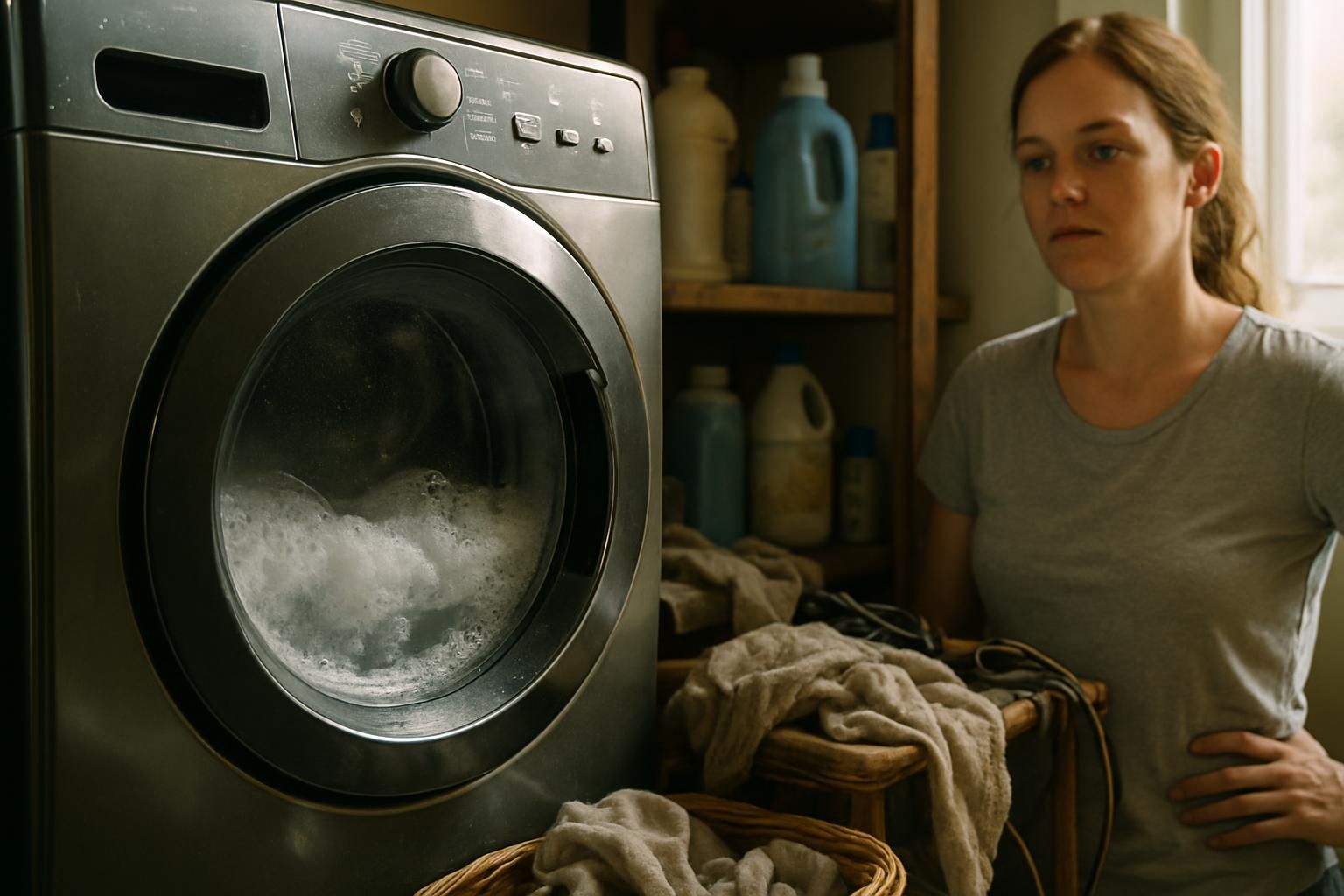
Yes. White vinegar, baking soda, and chlorine bleach work well on odor and residue. These staples break down soap film and mildew so the machine runs cleaner.
Cleaning with Vinegar
White vinegar is a mild acid, which means it dissolves mineral deposits and soap film. Pour two cups into the drum and run a hot cycle in a front-loader. For a top-loader, fill with hot water first, add the vinegar, and soak for one hour before finishing the cycle.
For a deeper clean, follow with 1/2 cup of baking soda in a short hot cycle. The mix of vinegar then baking soda neutralizes odor without harsh chemicals.
Cleaning with Baking Soda
Baking soda is a gentle abrasive and a deodorizer. Add one cup to the empty drum and choose the hottest, longest cycle. It breaks up residue left by detergents and softeners and tackles musty smells from mildew.
When the cycle ends, wipe the drum, door, and seals with a clean cloth. A monthly baking soda rinse works for both front-loading and top-loading washing machines.
Using Bleach Safely
Bleach sanitizes the drum and removes tough odors. Follow the manufacturer’s instructions, wear gloves, and open windows for airflow. Never mix bleach with vinegar, ammonia, or any other cleansers.
Always dilute bleach with water if directed by your manual. Safe use protects clothing and machine parts. Many owners rotate bleach, vinegar, and baking soda across months to keep odor away.
Conclusion
Monthly care keeps the washing machine clean and laundry smelling good. Focus on the gasket, the detergent drawer, and the filter. A hot cleaning cycle with a washing machine cleaner, vinegar, or bleach makes a clear difference.
Leave the door open to improve airflow and block mildew. With a steady routine and simple products like baking soda, the washer lasts longer and delivers cleaner clothes for the whole family.
Safety and maintenance tips: Always ensure proper ventilation in the laundry area and wear gloves when handling cleansers such as bleach. Consult your washing machine manual for safe use of chemical cleansers and protective measures. For an eco-friendly approach, use natural cleansers like baking soda and white vinegar, which help maintain a clean washing machine while reducing harsh chemicals. If any part of the laundry machine continues to have odor or buildup after cleaning, repeat the cleaning cycle and refer to troubleshooting guidelines provided by the manufacturer.
FAQs
1. How often should you clean a washing machine to prevent odor and buildup?
Clean your washer once a month to stop odor and residue from forming. Regular cleaning keeps your appliance running well and helps avoid musty smells.
2. What steps remove odor from a washing machine most effectively?
Wipe the drum, door seal, and detergent tray with hot water mixed with white vinegar or baking soda. Run an empty hot wash cycle using either cleaner to break down grime and kill odor-causing bacteria.
3. Can detergent alone keep my washer free of buildup?
Detergent does not remove all soap scum or mineral deposits over time; these can collect in hidden parts like hoses or seals. Use targeted cleansers such as white vinegar or specialized tablets for deep cleaning.
4. Is it necessary to leave the washer door open after use?
Leaving the door open allows air to circulate inside, which dries out moisture that causes mold growth and bad smells. This simple step reduces odor risk between deep cleans while protecting your laundry equipment’s lifespan.
References
- https://www.consumerreports.org/appliances/washing-machines/how-to-minimize-mold-in-your-washing-machine-a6065828553/
- https://www.howards.com/blog/how-to-clean-a-smelly-washer-keep-it-smelling-fresh?srsltid=AfmBOooZ9kNsmPoGYbAWUu02st28s2nvZ8f0HPsBUDvgM44ZibcVIN3u (2025-09-26)
- https://www.howards.com/blog/how-to-clean-a-smelly-washer-keep-it-smelling-fresh?srsltid=AfmBOopaDkadYoTkHSVhFf1v-tObp6cAmVfTmICPS5VrbN8kSv_Oam9P (2025-09-26)
- https://www.homedepot.com/c/ah/how-to-clean-a-washing-machine/9ba683603be9fa5395fab90ae6e5848
- https://www.howards.com/blog/how-to-clean-a-smelly-washer-keep-it-smelling-fresh?srsltid=AfmBOopRHTleOrMzwXH1ebyH4hE2aRQ3hSsIa4ZUdBX6Xhzey_lem3IA (2025-09-26)
- https://www.fredsappliances.com/blog/cleaning-front-load-washers-guide (2024-12-20)
- https://www.facebook.com/groups/1074379686948858/posts/1402680784118745/
- https://www.affresh.com/knowledge-hub/how-to-clean-a-front-load-washer/
- https://www.facebook.com/groups/MamasFavoriteRecipes/posts/3022044534611989/
- https://www.whirlpool.com/blog/washers-and-dryers/clean-washing-machine.html
- https://www.thespruce.com/clean-top-load-washing-machine-5073254
- https://www.aztecappliance.com/blog/how-to-clean-a-top-load-washing-machine?srsltid=AfmBOor0rjmfOdo0pX-PYHIj8hVk_en5MXSTDg_-yNZJGal73GqH5qS8
- https://pmc.ncbi.nlm.nih.gov/articles/PMC8231443/
- https://www.whirlpool.com/blog/washers-and-dryers/smells-in-front-load-washer.html
- https://www.howards.com/blog/how-to-clean-a-smelly-washer-keep-it-smelling-fresh?srsltid=AfmBOoqvdcRJR2zpHS8JJ_eRRUzqldj_dilZywE49E2xzY-K31dbBak7 (2025-09-26)
- https://www.facebook.com/groups/954107215354486/posts/1462079571223912/
- https://www.howards.com/blog/how-to-clean-a-smelly-washer-keep-it-smelling-fresh?srsltid=AfmBOoqu-C0BRRkWguqfFli76leLVByZ9RVXlSAMuPD6EfU62ny15uqD (2025-09-26)
- https://www.mollymaid.com/practically-spotless/2020/february/how-to-clean-a-smelly-washer/ (2025-09-17)






